John Wilkinson (Franklin automobile)
| John Wilkinson | |
|---|---|
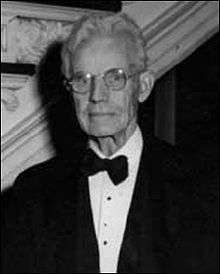 John Wilkinson in 1947 | |
| Born |
February 11, 1868[1] Syracuse, New York, United States[2] |
| Died |
June 25, 1951 (aged 83) Syracuse, New York, United States |
| Education | Cornell University |
| Occupation | Mechanical engineer, Inventor, Business |
| Religion | Unitarianism |
| Spouse(s) | Edith Belden (Known as DeeDee) |
| Children | Helen Wilkinson Blagbrough (1897-1947), Anne Belden Wilkinson Sherry (1899-1997), John Belden Wilkinson (1905-1951) |
| Parent(s) |
Joshua Forman Wilkinson (1829-1889) Louisa B. Rayner[2] |
John Wilkinson (February 11, 1868 - June 25, 1951) was born in Syracuse, New York. He invented the air-cooled motor which was used in the Franklin (automobile) produced by H. H. Franklin Manufacturing Company where he was chief engineer and designer from 1902 to 1924.
He was a native of Syracuse and a member of an established, respected, wealthy family. His grandfather, John Wilkinson (1798–1862), was one of the original pioneers of Upstate, New York.[3] As a young man, Wilkinson, Sr. was a city planner and named the newly incorporated village, Syracuse.[4]
Biography
He was the son of Joshua Forman Wilkinson (1829–1889) and Louisa B. Rayner and youngest of five children. His father was named after Judge Joshua Forman, the founder of the village of Syracuse who was a personal family friend.[5] "J. Forman" Wilkinson served as a soldier in the Civil War with the 149th Infantry of New York State volunteers.[1]
Early life
After the war, J. Forman Wilkinson had formed a partnership with his brother, Alfred Wilkinson, and established a bank named Wilkinson & Company; however, it failed on December 9, 1884, when John Wilkinson was an adolescent.[5]
His grandfather, John Wilkinson settled in the area on the Southside of Onondaga Lake in Central New York, where he was a lawyer and the first Postmaster of Syracuse.[6] He acquired some farm land, extending for some distance around where the Globe Hotel stood. The property remained in the family until April 1889, when they sold it to satisfy the creditors of a failed banking endeavor, Wilkinson & Company. At that time, John Wilkinson of Chicago filed deeds in the County Clerk's office, conveying to him, the residences of both brothers (on James Street) and the building which "has since become known in court as the Globe property."[7]
Both sons died untimely deaths. John Wilkinson's father, J. Forman Wilkinson, died on May 4, 1889, at the family home on James Street in Syracuse with pneumonia two weeks after the property was sold and Alfred Wilkinson died in July, 1886.[5]
John Wilkinson's four siblings were;[5]
- Mrs. Ralph S. Bowen
- Rebecca Wilkinson
- Theodore Wilkinson - Chemist for the Anaconda Mining Company in Montana.
- Forman Wilkinson
Education
John Wilkinson graduated from Syracuse High School about 1885.[1] He was described as "rugged, good-natured, outgoing and athletic" and attended Cornell University where he starred in tennis, baseball, track and football and managed to finish his coursework with honors. While at Cornell, he was a member of Psi Upsilon, a college fraternity.[1] He earned a degree in mechanical engineering in 1889 and found a job with a local bicycle manufacturer, a "hot" technology of the period.[8]
Personal life
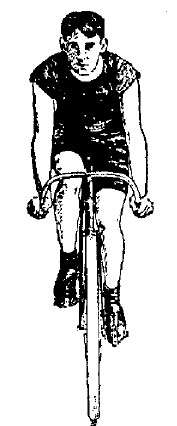
John Wilkinson was married to Edith Belden on April 23, 1896. She was born on September 24, 1869, and was the third child of Mead Belden and Gertrude Woolston Belden. She was educated in Keeble School of Syracuse and at Pennsylvania State University at Ogontz, Philadelphia, Pennsylvania.[1]
The couple had three children, two daughters and a son;[1]
- Helen Wilkinson Blagbrough (born April 5, 1897) (Died 1947)
- Anne Belden Wilkinson Sherry (born October 9, 1899) (Died 1997)
- John Belden Wilkinson (born February 13, 1905) (Died ca. 1951)
Business life
His first job was as machinist for E. C. Stearns & Company of Syracuse, where he stayed a short three months. He departed to Brooklyn, New York and found employment with Henry R. Worthington Pump Company and he stayed a year. Wilkinson returned to Syracuse and was hired as a draughtsman with Solvay Process Company. He remained in their employment for four years.[1]
Bicycle design and racer
Always athletic, by 1880, Wilkinson participated in another sport, bicycle racing and went on to become one of the country's leading racers.[9] After college, he went on to become a champion cyclist and also developed a keen interest about the inner-workings of internal combustion engines and motor cars.[8]
Wilkinson, a member of Syracuse Athletic Association, no longer holds the 10 feet (3.0 m) road record over the Cicero course. On July 19, 1893, William Van Wagoner of New Jersey who was also riding for Syracuse, made a new record by riding the distance in 31:03, reducing Wilkinson's record by 12 seconds. It was a "great feat" as the wind was blowing stiff from the north.[8]
He went to work for the Syracuse Cycle Company on Wyoming Street as a designer where he stayed for about four years.[1] In 1895, he designed and patented the Syracuse quadruplet, the "fastest cycle in the world," establishing a record of 1:45 for a three lap track.[9] Wilkinson also designed the company's well-known Crimson Rim.[10]
 Syracuse Cycle Company - advertisement - The Daily Standard, April 21, 1896 [11] |
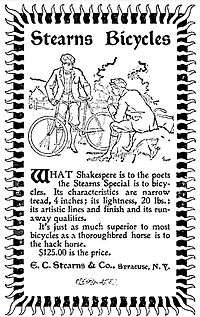 Stearns Bicycle - advertisement - The Philistine, December, 1896 |
 Syracuse Cycle - advertisement, The Syracuse Daily Standard, May 15, 1897 |
 Stearns Bicycle - advertisement - Syracuse Post-Standard, June 5, 1901 |
Early inventions
After leaving Syracuse Cycle Company, Wilkinson dedicated the next two years largely to experimenting with automobiles, a brand new innovation on the market.[1] He designed and built two prototype vehicles. In the summer of 1898 he tinkered with a one-cylinder air-cooled, gasoline engine and by January 1, 1900, he demonstrated his first automobile which traveled at 35 miles per hour (56 km/h).[1]
In 1900, Wilkinson invented an air compressor self-starter which was the first of its kind for an automobile (although Kettering claimed he invented the starter in 1911). Wilkinson showed it to a group of friends and was able to connect to the New York Automobile Company officers including; George H. Bond, Sr. secretary and Ernest I. White, prime mover.[12] Associated with this endeavor were Fred D. White, Arthur R. Peck, Edward N. Trump, Alexander T. Brown, founder of the Brown-Lipe Company, and Louis Will of Will & Baumer Candle Company.[8]
His designs may have caught the attention of the group of New York City businessmen, however, the men couldn't decide whether to put Wilkinson's car into production. One day when he was visiting the C. E. Lipe shop, where the H. H. Franklin Manufacturing Company die-casting business was located, one member of the group introduced Wilkinson to Herbert H. Franklin, who took a ride in Wilkinson's second prototype. Franklin was impressed and discussed the idea with Alexander T. Brown, one of the members of the New York Automobile Club. Between them, it was agreed that Wilkinson should drop all previous experiments and start anew.[9] Franklin invested $1,100 so that Wilkinson could build a third prototype which went on to become Franklin's first production model.[8]
Later the business endeavor with the New York businessmen disintegrated due to Fred White's death and the new business arrangement Wilkinson had formed with Herbert H. Franklin.[9]
Franklin auto
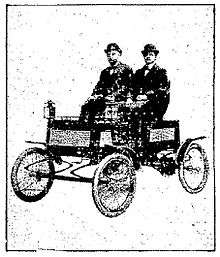
Wilkinson signed a formal contract with Franklin to go into business with him producing air-cooled automobiles on July 1, 1901.[9] Alexander T. Brown and Herbert Franklin combined efforts and created a startup they named "Brown and Franklin" to commence building and promotion of the Franklin automobile. The initial work of the business was financed in equal amounts by both men. "So great was Franklin's faith in the proposition, that he borrowed every cent of the money."[9]
The original staff consisted of six or seven people. "In one corner, with a drafting board in front of him, sat John Wilkinson and the bookkeeper, the stenographer and others were at desks and tab1es, here and there. Back in the original machine shop were two mechanics. These two men were building the first car. For two months they had worked shaping up this part and shaping up that, until the day came when they had a complete car." Later, Brown and Franklin was absorbed by the H. H. Franklin Manufacturing Company.[9]
The company's first home was a four story building at the northeast corner of West Fayette and South Geddes streets, leased from the Brown Lipe Gear Company.[14]
On November 1, 1901, the H. H. Franklin Manufacturing Company was restructured and the Franklin Automobile Company was spun off into a separate entity. Herbert Franklin named the business after himself and was the president and primary shareholder. He gave John Wilkinson stock and appointed him chief engineer. In the early days, Franklin ran the business side and Wilkinson made the engineering and manufacturing decisions. Alexander T. Brown and Willard Lipe were also important figures in the founding of the company and the original office was in the Lipe machine shop.[15]
From the onset, Wilkinson wanted to build a car that would be light in weight and economical. He believed that it should be the "acme of simplicity, so that the owner of a Franklin Car would have as little as possible to do with it mechanically." From the very beginning, the first drawings contained the idea of a self starter which was to be operated by compressed air.[9]

In 1910, Wilkinson was promoted to vice-president of the company.[14]
Aircraft engine
In 1917, during World War I, Wilkinson was selected to work with Cal Vincent of Packard to design the Liberty V-12, a 450-horsepower aircraft engine. He was one of three engineers selected from the Society of Automotive Engineers for the special duty.[12]
The engine was first designed as water-cooled and was later revamped at McCook Field in Dayton, Ohio, to a V-12 air-cooled engine. "These first experiments were the basis for later air-cooled cylinder designs used during World War II and today in military as well as commercial aircraft."[9]
Career change
In late 1924, John Wilkinson had a falling out with Herbert Franklin over the insistence by Franklin that the new designs should "look more like other cars." The company had taken a lot of criticism in the popular press and from dealerships because of their unconventional front hood that didn't sport a radiator.[8] He retired by the end of 1924. During his time at Franklin he had been chief engineer, vice-president and a director of the H. H. Franklin Manufacturing Company.[12]
Immediately after his departure from Franklin, he began development work for Dodge Brothers then headed by his old friend Fred Haynes where his first effort was the Dodge water-cooled "Victory Six."[9]
Soon after his retirement from Franklin, on May 16, 1925, Wilkinson announced that he might form a new company to produce his "new invention," an automobile that was under construction and "which is surrounded by secrecy."[16]
According to Wilkinson, formation of the new company was dependent upon the success of the initial model. At that time, Wilkinson stated that he was "working night and day on the car and will subject it to the severest tests before making definite decision on the production." The car that was in conception had conventional looks with a new, radical engineering design, although it still had an air-cooled engine. The new car was being worked on in a machine shop in Marcellus Street, not unlike conditions in the early Franklin Automobile Company.[16]
In 1942 he was cited for his air-cooled motor in helping the war effort during World War II.[12]
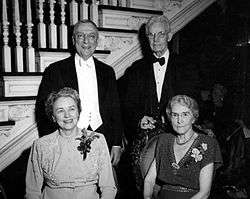
Later life
In July 1927, Wilkinson purchased a new Falcon-Knight sedan. He had three cars but used the new car to go back and forth from his summer home in Skaneateles, New York. C. C. Russell, president of the Rossell-Knight Company, delivered the car to Wilkinson who took the car on a trip to Detroit, Michigan where the inventor "also had interests." He was working on inventions in auto manufacture "at the present time."[17]
In the early 1900s, Wilkinson helped found the Society of Automotive Engineers with Henry Ford[12] and in 1947 he was honored for life membership at a special meeting in Syracuse. "A great engineer, Mr. Wilkinson, a great man acknowledged as such by this great engineering society many, many times during his career."[9]
He was an honorary member of the Onondaga Golf and Country Club, formally the Hiscock Golf Club.[12]
He was married for 55 years until his death on June 25, 1951. He was buried in Oakwood Cemetery.[12]
By 1954, his widow still lived in Syracuse at 1065 James Street.[9] When Herbert H. Franklin was alive, he lived right down the street at the Hamilton White homestead at 1033 James Street.[14]
References
- 1 2 3 4 5 6 7 8 9 10 Fitch, Charles Elliott. Encyclopedia of biography of New York. The American Historical Society, New York, N.Y., 1916, pg. 123.
- 1 2 "John Wilkinson". Family Tree Maker, 2010. Retrieved 2010-07-24.
- ↑ "1915 Franklin - Vintage - Jay Leno's Garage". NBC Corp, Inc., New York. N.Y., 2010. Retrieved 2010-07-23.
- ↑ "Revolutionary War veteran's son gave city its name". The Post-Standard. Syracuse, New York. August 27, 2002.
- 1 2 3 4 "J. F. Wilkinson Dead". Sunday Herald. Syracuse, New York. May 5, 1889.
- ↑ Hardin, Evamarie. Syracuse landmarks: an AIA guide to downtown and historic neighborhoods. Onondaga Historical Association, Syracuse University Press, 1993. Retrieved 2010-07-23.
- ↑ "Winning in the Test Case". Syracuse Daily Standard. Syracuse, New York. June 14, 1886.
- 1 2 3 4 5 6 "1932-1934 Franklin V-12". HowStuffWorks, Inc., 2008-2010. Retrieved 2010-07-17.
- 1 2 3 4 5 6 7 8 9 10 11 12 Doman, Carl. "The Two Johns (1954)". The H. H. Franklin Club, Inc., Syracuse, N.Y., November 17, 1998.
- ↑ LaRue, Arlene (February 13, 1983). "When Syracuse was hub of the bicycle world". Syracuse Herald-American. Syracuse, New York.
- ↑ "Syracuse Cycle Company - advertisement". The Daily Standard. Syracuse, New York. April 21, 1896.
- 1 2 3 4 5 6 7 "John Wilkinson Dies; Invented Engines, Car". Syracuse Herald Journal. Syracuse, New York. June 26, 1951.
- ↑ "Record run over rough country roads". The Post-Standard. Syracuse, New York. February 21, 1902.
- 1 2 3 Early, Frank J. "The Story of Herbert H. Franklin". The H. H. Franklin Club, Inc., Syracuse, N.Y., from Air Cooled News - Issue No. 10, July 1956.
- ↑ Knauss, Tim. "Industrial Age Fed Syracuse Boom". Syracuse Then and Now, 2010. Retrieved 2010-07-22.
- 1 2 "New Automobile Firm Planned by Wilkinson". Syracuse Herald. Syracuse, New York. May 14, 1925.
- ↑ "Wilkinson Is Owner of New Falcon". Syracuse Herald. Syracuse, New York. July 31, 1927.